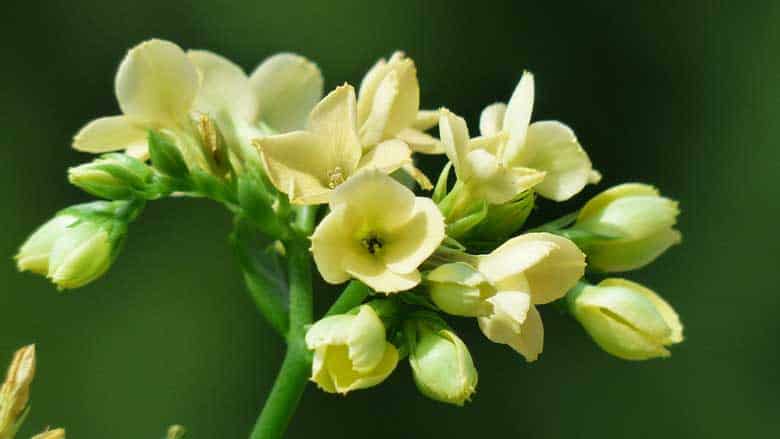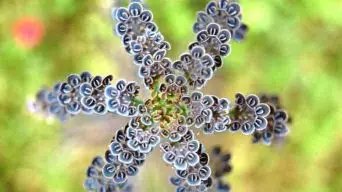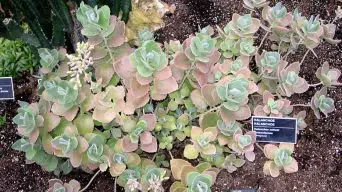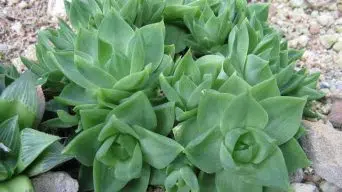The Kalanchoe blossfeldiana succulent plant is a beautiful, easy to care for houseplant that can be propagated easily.
The Kalanchoe blossfeldiana is also commonly known as Flaming Katy, Florist Kalanchoe, Christmas Kalanchoe, and Madagascar Widow’s-Thrill.
This article will provide you with everything you need to know about how to grow and care for this unusual plant so that they are happy and healthy!
Overview
The Kalanchoe genus is a large group of succulent perennial plants native to Madagascar and South Africa.
There are over 200 different species of the genus Kalanchoe with many variations in flower color, leaf shape, and size.
Some of the most known Kalanchoe varieties include Kalanchoe daigremontiana, Kalanchoe tomentosa, and Kalanchoe blossfeldiana.
The Kalanchoe Blossfeldiana plant is a succulent perennial that originates from Madagascar. This flowering plant is commonly found in gardens, parks, and public spaces.
This succulent plant can grow up to 12 inches in height and up to 15 inches wide.
The Kalanchoe blossfeldiana succulent has large green leaves that can grow up to 12 inches in width, with a length that varies between 24-36 inches.
The plant has dense clusters of flowers that grow on terminal spikes or racemes that bloom in the fall and winter months.
The Kalanchoe flowers vary in color from white to pinkish-red and yellow depending on their age.
This plant is often used in the landscaping of commercial spaces because it requires very little water, making this succulent a drought-tolerant option for gardens.
How To Care for Kalanchoe Blossfeldiana (Flaming Katy)
Sun Exposure & Light Requirements
The best type of lighting for the Kalanchoe blossfeldiana is an indirect bright light that can come from an east or west-facing window.
These plants will also do well under fluorescent lights and grow slowly just as long as they get enough exposure to natural sun rays at least 12 hours per day.
Providing too much direct sunlight on these types of succulents could result in scorching, wilting, browning leaves, and even death if left exposed for over two hours.
Providing partial shade is the best solution to protect these plants from too much direct sunlight.
Blooming Kalanchoe plants should be moved to a location with indirect light for more hours of the day, and this will help them stay healthy.
Watering Requirements
Watering Kalanchoe blossfeldiana regularly is essential for keeping the plant healthy. Too much water will kill it, and too little will harm its growth.
Water when the soil becomes dry to the touch, but never let the potting mix become completely dried out before you do so; this could lead to root rot which can be fatal.
Kalanchoe blossfeldiana plants are native to Madagascar and commonly found in the arid parts of Africa, which is why they require dry soil.
They can adapt to other climates by being kept outdoors in a shady area for at least part of the week to keep their roots moist while receiving fresh air.
A fully grown Kalanchoe plant will need about one inch (25 cm) of water every two weeks, but its requirements will be much more significant when it’s young.
The best time to water your plant is just before noon so it has enough time to absorb all the moisture during the day or evening. This helps prevent diseases from spreading throughout the leaves and making them brittle or discolored.
Soil Requirements
Soil requirements are one of the most important things to get right when taking care of a Kalanchoe Blossfeldiana succulent plant.
All Kalanchoes need soil that drains quickly and is slightly gritty, as they grow in dry climates where there’s not much water available for them to take up at their roots.
When it comes to growing your Kalanchoe, the best option is a well-draining potting mix designed for cacti and succulents.
The potting mix should mostly be composed of sand or other porous material like crushed rocks, allowing drainage and good aeration.
Some organic matter should also be mixed into the soil – this can include bark chips, composted leaves, peat moss, or sphagnum moss.
Temperature and Humidity
The Kalanchoe Blossfeldiana will grow in a wide variety of climates but prefers warmer temperatures with higher humidity levels than what is found in the typical home garden or greenhouse.
This plant’s ideal indoor temperature range at night is 60-80 degrees Fahrenheit (15-27 Celsius). During the day, it should be 70-90 F (21-32 C) during daytime hours.
Humidity can be around 50% relative to keep leaves from drying out too much when conditions get hot outside or indoors without air conditioning.
Fertilizing
Fertilizing Kalanchoe blossfeldiana plants is a must if you want them to reach their maximum potential.
However, this can be difficult because the plant does not like over-fertilization, and too much of it may kill it.
The best way to fertilize is using liquid fertilizer containing 20% nitrogen (N), which will help improve leaf growth and flower production in mature plants.
You should only give your Kalanchoe two or three doses throughout the year at most, depending on how often they are watered in between.
You also need to know when NOT to fertilize Kalanchoes:
- Early spring, when they first start growing in warm weather
- Late fall before the first frost
- When nighttime temperatures are below 55 degrees Fahrenheit
Do not fertilize during these times because it will cause the plant to produce excess growth, which will cause dehydration, and the leaves may turn yellow.
The best times to fertilize a Kalanchoe blossfeldiana are in the late spring or early fall before nighttime temperatures drop below 55 degrees Fahrenheit, and before the first frost.
This will increase flower production size and quality for the following year.
Potting and Repotting
Kalanchoe blossfeldiana will need to be repotted every year or two.
To repot the succulent, gently remove it from its pot and wipe away any old soil around the roots with your hands.
Then trim away any dead or diseased leaves to ensure they don’t spread to other plants in the container.
Finally, put some fresh dirt over the roots and pack it down lightly before putting back into a pot of new soil at double its previous size.
The best type of pot for the Kalanchoe Blossfeldiana succulent plant is a terracotta pot with drainage holes in the bottom.
This type of container allows water to drain out from the soil so that it doesn’t rot the roots, making them susceptible to pests and disease.
The size of the pot should be about double the size of the previous pot.
Pruning
After a few months, the Kalanchoe blossfeldiana succulent might become overgrown and start to look less attractive.
In this case, it’s good practice to give them light pruning with a blade or scissors for them to have healthy growth throughout the whole plant.
This can also help prevent any diseases that may have been present on the leaves, which are now cut off from spreading.
When cutting, make sure not to trim too close to its base because it will cause stress as well as a shock for your Kalanchoe succulent. Instead, try and stay about one inch away from its base before you put those shears down!
If you feel they need more intervention, trim your succulent outer edges to give them a fresh start.
If you plan on pruning any leaves or stems with flowers (or flower buds for Kalanchoe blossfeldiana), ensure not to break them. This could cause unnecessary stress and also prevent blooming in the future!
Pests and Diseases
Pests and diseases are generally not a problem with Kalanchoe blossfeldiana plants.
However, occasionally they may be attacked by spider mites or aphids.
These two pests can usually be controlled using insecticidal soap spray made from dish-washing liquid mixed in water.
If these solutions don’t work, you’ll need to use an organic pesticide such as neem oil.
Also, some diseases that can affect the Kalanchoe are powdery mildew and leaf spot.
Powdery mildews are usually caused by a lack of air circulation, which can be corrected by moving the plant to an area with better airflow or simply trimming back some of the infected leaves.
Leaf spots on Kalanchoe blossfeldiana plants are more challenging to get rid of. Still, if you catch them early enough, they should clear up without any intervention from you.
In general, Kalanchoe blossfeldiana plants are pretty hardy and can usually self-heal.
How To Care for Kalanchoe Blossfeldiana in Winter
In winter, the Kalanchoe blossfeldiana succulent plant will need to be watered more often.
It should also get a lot of bright light but no direct sunlight, as this could burn the succulent leaves.
Most indoor plants cannot tolerate freezing temperatures. Therefore, you would want to keep them in an area where they can’t receive any frost or ice.
The temperature inside the house during winter is typically warmer than outside.
This means that some people can grow their Kalanchoe blossfeldiana indoors all year round if given enough light for its location within the home (for example, near windows).
How To Propagate Kalanchoe Blossfeldiana (Flaming Katy)
Kalanchoe blossfeldiana succulents can be propagated through offsets or stem cuttings.
Stem Cuttings
Stem cuttings are the easiest way to propagate Kalanchoe blossfeldiana.
They can be taken from a mother plant and placed in water or soil with good drainage, and they will grow roots if given enough time.
The root cutting should have at least two nodes when inserted into the soil for best results, but more than three is preferable.
- Place stem cuttings in clean, humid rooting media within direct sunlight (for indoor plants). Rooting hormones may also help speed up growth during this process occasionally.
- Stem Cuttings do not need any fertilization until after they begin developing leaves again as adults. This usually takes about six weeks for most varieties of kalanchoes.
- Stem cuttings can be taken from the plant at any time of year, but they are best in warmer months.
Offsets
The most common method to propagate Kalanchoe blossfeldiana is through offsets.
These are baby plants that grow off the mother plant and can be easily removed from it.
The best time for this type of propagation is in early summer when offsets will have developed a few leaves on top of them, indicating they’re ready to be separated from the parent plant.
This should only take place after your Kalanchoe Blossfeldiana has reached full maturity with at least six months’ worth of growth. Otherwise, you’ll risk damaging the root system, which could lead to rot or death.
To remove the offsets, twist them off from their mother plant and pot them up.
Kalanchoe Blossfeldiana offsets should be placed in a pot with a well-draining, gritty soil mix.
Be sure there are plenty of holes for the excess water to drain out and that it’s wide enough so you can get your hand inside easily when necessary.
After the Kalanchoe Blossfeldiana offset develops roots, remove them from the pot, and transplant them into a larger container.
You will need to be patient and wait for at least a year before the plant starts to flower again.
Most people will choose to leave their Kalanchoe Blossfeldiana offsets on the mother plant. Still, if you’re worried about overcrowding or have limited space, removing them is safe when they reach half the parent’s size.
Is the Kalanchoe Blossfeldiana Toxic?
The Kalanchoe blossfeldiana is not toxic to humans and pets.
However, some people may have allergies and may be sensitive or allergic to a Kalanchoe blossfeldiana plant.
If you know someone in your household has an allergy to plants, then it is best not to bring succulent houseplants indoors for fear of triggering symptoms.
Final Thoughts
The Kalanchoe blossfeldiana succulent plant is beautiful, easy to maintain, and an excellent option for people looking for an alternative that is not a typical houseplant.
Kalanchoe blossfeldiana care is not difficult, and the plant is really easy to propagate.
As long as you follow these simple steps, your Kalanchoe blossfeldiana should be happy and healthy for a very long time!
All in all, kalanchoes make great additions to any home, office space, or outdoor spaces such as gardens, patios, and anywhere else you want some pretty green plants!







